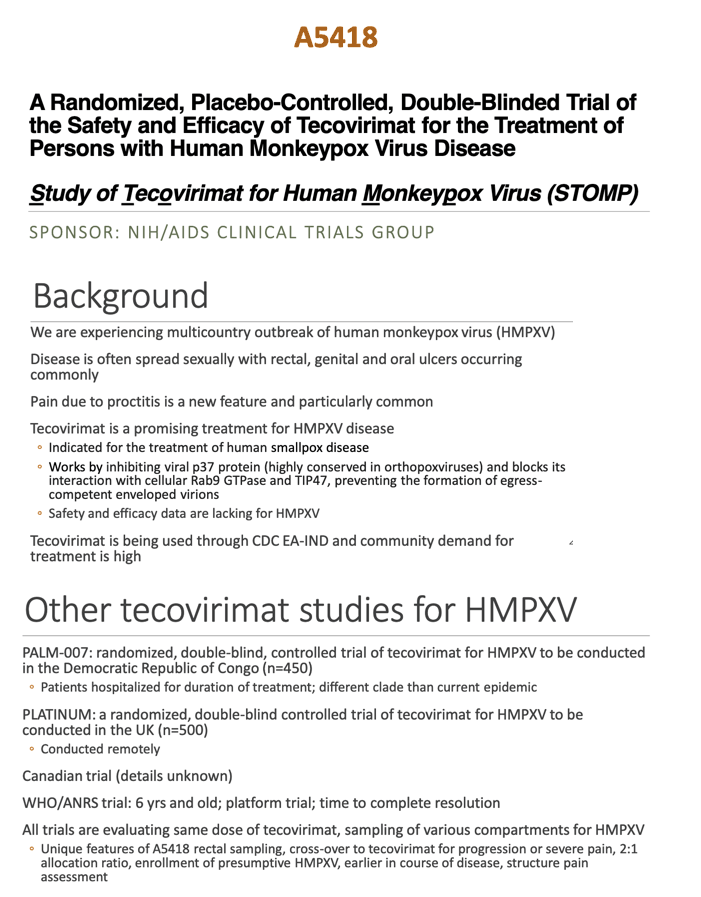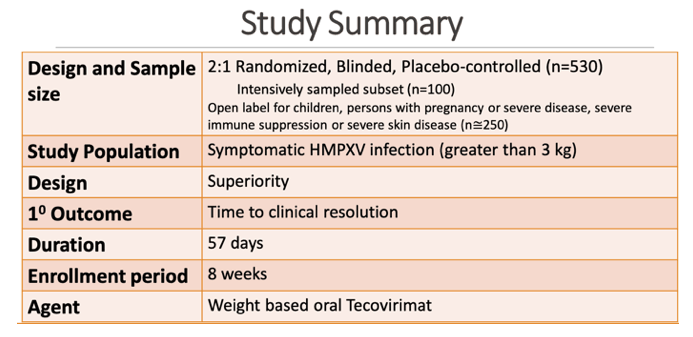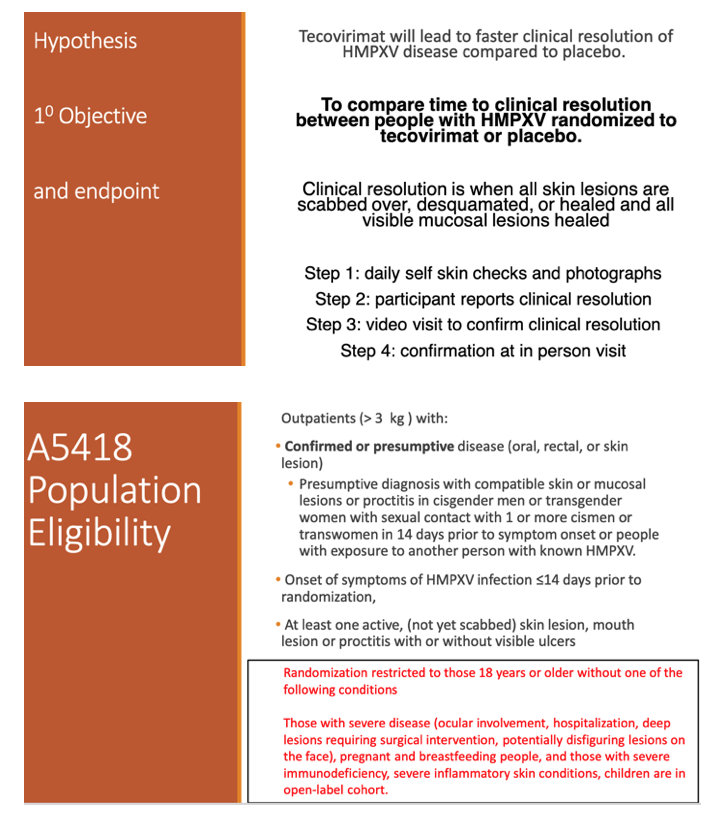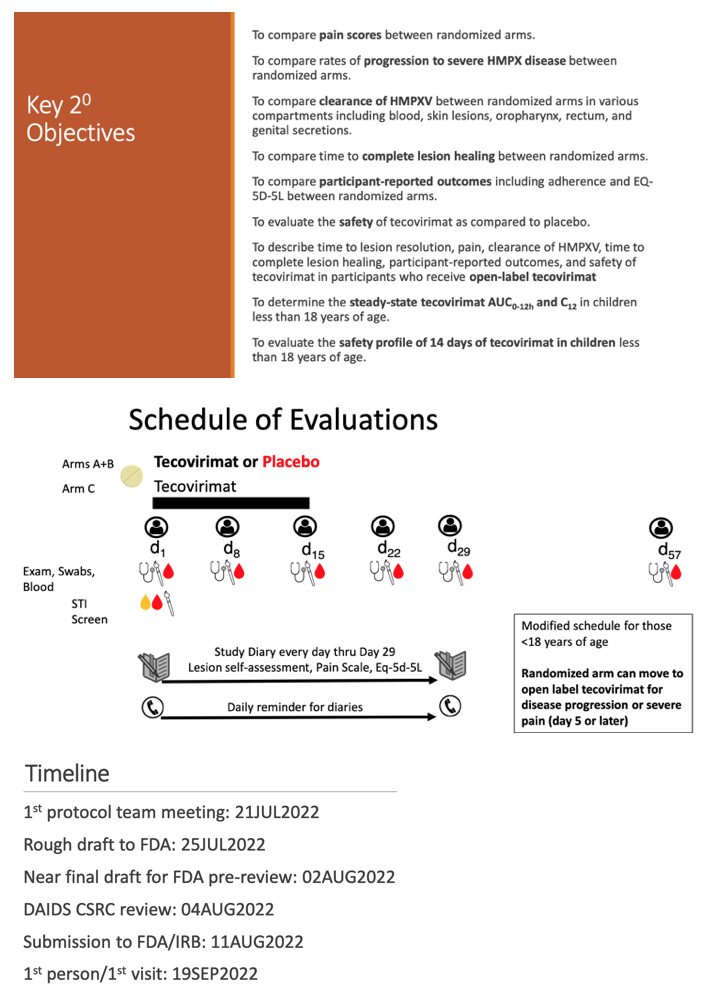| |
Monkeypox Treatment & Prophylaxis in
PLWH; NIAID STOMP TPOXX Study
|
| |
| |
https://www.stomptpoxx.org/aboutTrial
Study sites: https://www.stomptpoxx.org/stompsites
STOMP Study Description
The study of Tecovirimat for treatment of human Monkeypox (STOMP) is a NIAID-funded clinical trial led by the ACTG to evaluate the effectiveness of the antiviral tecovirimat, also known as TPOXX, for the treatment of human Monkeypox infection.
Who can join?
Adults and children of any age with Monkeypox are eligible to enroll in this trial. See list of participation sites below.
What do I need to do in the study?
Step 1: daily self skin checks and photographs Step 2: participant reports clinical resolution Step 3: video visit to confirm clinical resolution Step 4: confirmation at in person visit
What treatments or drugs are involved with this study?
Tecovirimat, manufactured by the pharmaceutical company SIGA Technologies, Inc. (New York), is approved by the FDA for the treatment of smallpox. The drug prevents the virus from spreading in the body by preventing virus particles from existing human cells by targeting a portion found on both the variola virus, which causes smallpox, and the monkeypox virus.
Duration of Study
57 days
------------------------
STOMP Study Description, slides
Clinical Considerations for Treatment and Prophylaxis of Monkeypox Virus Infection in People with HIV
Considerations for use in people with HIV
Tecovirimat (a.k.a. TPOXX, ST-246)
Few interactions are expected with antiretroviral therapy for HIV. However, none of the identified drug interactions should preclude coadministration of tecovirimat and antiretroviral therapy. According to the Liverpool HIV drug interactions database, tecovirimat may result in a reduction in levels of non-nucleoside reverse transcriptase inhibitors (NNRTIs) doravirine and rilpivirine, and the CCR5 antagonist maraviroc. Dose increases for doravirine, rilpivirine, and maraviroc could be considered when co-administered with tecovirimat and for two weeks after completion of tecovirimat therapy (see Liverpool website for details). However, based on evidence graded very low quality and the short treatment course of tecovirimat, some experts believe neither dose adjustments nor additional ART are needed. Consultation with local pharmacists is suggested.
HIV ART DDIs - When co-administering tecovirimat with long-acting
cabotegravir/rilpivirine, tecovirimat might result in a reduction in rilpivirine levels. Per the Liverpool HIV interactions database, the addition of oral rilpivirine 25mg once daily (or the patient's prior ART regimen) during treatment with tecovirimat and for approximately 2 weeks after the end of treatment could be considered. However, some experts believe no additional therapy is necessary during tecovirimat treatment. Initiation of long-acting cabotegravir/rilpivirine should be avoided during tecovirimat therapy and for 2 weeks after the conclusion of tecovirimat.
Cidofovir and Brincidofovir
Cidofovir is contraindicated in patients with serum creatinine >1.5 mg/dL because of the nephrotoxicity associated with these medications. Therefore, co-administration of cidofovir with tenofovir disoproxil fumarate (TDF) is not recommended. If concomitant use of TDF and nephrotoxic agents is unavoidable, renal function should be monitored closely. Cidofovir is typically co-administered with probenecid both to reduce nephrotoxicity and boost its effectiveness. Probenecid substantially increases zidovudine plasma levels; if co-administered, zidovudine should either be temporarily discontinued or decreased by 50% on the day of cidofovir-probenecid administration to avoid zidovudine-induced hematological toxicity.
Brincidofovir has clinically relevant drug interaction with protease inhibitors (PIs), cobicistat, and fostemsavir that may require modification of therapy. If PIs or fostemsavir are co-administered with brincidofovir, clinicians should monitor closely for adverse reactions (e.g., elevations in transaminase levels) and dosing of antiretroviral therapy should be delayed for at least 3 hours after brincidofovir administration.
Both cidofovir and brincidofovir have interactions (including contraindications for use) with other medications that should be assessed by the clinical team. Currently, only cidofovir is available, either commercially or from the SNS.
Vaccinia Immune Globulin Intravenous (VIGIV)
There are no specific contraindications for use of VIGIV among people with HIV, and no known or anticipated interactions with antiretroviral therapy.
Monkeypox can cause keratitis. Caution should be exercised when using VIGIV in the treatment of people with active keratitis, as increased corneal scarring was observed in an animal model of vaccinia keratitis.
VIGIV is contraindicated in individuals with a history of anaphylaxis or prior severe systemic reaction association with the parenteral administration of this or other human immune globulin preparations. VIGIV is contraindicated in IgA-deficient patients with antibodies against IgA and a history of IgA hypersensitivity.
Vaccination with live virus vaccines (e.g., varicella, measles, mumps, and rubella) should be deferred for 3 months after use of VIGIV.
For additional details regarding therapeutic recommendations, see Treatment.
Monkeypox & Covid Info from IDSA
What populations or communities does the CDC consider most "at risk" for monkeypox?
This is remarkable insofar as monkeypox is a disease that has very disproportionately affected gay, bisexual, and other men who have sex with men (MSM). Over 95% of cases worldwide are occurring in persons who report male-to-male sexual contact, and their median age is right around the mid-30s. Not surprisingly - but sometimes surprising to people who aren't aware of sexually transmitted diseases (STDs) - about 40% of patients with monkeypox are HIV positive. This does not reflect some biologic risk because of HIV infection, but rather, behavioral risk related to how people who have HIV acquired the infection. The incidence of certain STDs in this population is also around 40%.
We see that in a paper published by Thornhill and colleagues in The New England Journal of Medicine, a substantial fraction of MSM with monkeypox had more than five sexual partners in the last 3 months, and almost 30% were diagnosed with a sexually transmitted infection at the time they were diagnosed with monkeypox.
Overall, 98% of the persons with infection were gay or bisexual men, and 75% were White. The median age was 38 years. A total of 41% of the persons were living with HIV infection, and in the vast majority of these persons, HIV infection was well controlled; 96% of those with HIV infection were taking ART, and in 95% the HIV viral load was less than 50 copies per milliliter (Table 2). Preexposure prophylaxis had been used in the month before presentation in 57% of the persons who were not known to have HIV infection.
We report 528 infections diagnosed between April 27 and June 24, 2022, at 43 sites in 16 countries. Overall, 98% of the persons with infection were gay or bisexual men, 75% were White, and 41% had human immunodeficiency virus infection; the median age was 38 years. Transmission was suspected to have occurred through sexual activity in 95% of the persons with infection. In this case series, 95% of the persons presented with a rash (with 64% having ≤10 lesions), 73% had anogenital lesions, and 41% had mucosal lesions (with 54 having a single genital lesion). Common systemic features preceding the rash included fever (62%), lethargy (41%), myalgia (31%), and headache (27%); lymphadenopathy was also common (reported in 56%). Concomitant sexually transmitted infections were reported in 109 of 377 persons (29%) who were tested. Among the 23 persons with a clear exposure history, the median incubation period was 7 days (range, 3 to 20). Monkeypox virus DNA was detected in 29 of the 32 persons in whom seminal fluid was analyzed. Antiviral treatment was given to 5% of the persons overall, and 70 (13%) were hospitalized; the reasons for hospitalization were pain management, mostly for severe anorectal pain (21 persons); soft-tissue superinfection (18); pharyngitis limiting oral intake (5); eye lesions (2); acute kidney injury (2); myocarditis (2); and infection-control purposes (13). No deaths were reported.
Transmission
The suspected means of monkeypox virus transmission as reported by the clinician was sexual close contact in 95% of the persons. It was not possible to confirm sexual transmission. A sexual history was recorded in 406 of 528 persons; among these 406 persons, the median number of sex partners in the previous 3 months was 5 partners, 147 (28%) reported travel abroad in the month before diagnosis, and 103 (20%) had attended large gatherings (>30 persons), such as Pride events. Overall, 169 (32%) were known to have visited sex-on-site venues within the previous month, and 106 (20%) reported engaging in "chemsex" (i.e., sex associated with drugs such as mephedrone and crystal methamphetamine) in the same period.
A total of 70 persons (13%) were admitted to a hospital.
https://www.nejm.org/doi/full/10.1056/NEJMoa2207323
How should clinicians approach monkeypox treatment?
We really encourage people to take the pain story seriously. One of the first things I've learned is you really need to meet people where they are. When they explain their pain, accept it, be their ally. They really need you to listen to them, and don't hesitate to treat. Stool softeners are a simple solution to make defecation less painful if you've got a sore bum, and especially if you're going to move into using opioids for pain management.
A number of people with monkeypox may need opioids for a short period of time, and you want to absolutely make sure that you've got stool softeners on board because opioids can be constipating. Many of us are very sensitized around misuse of opioids and other addictive substances. I think this is a place though where you need to also respond to the voice of "I have a person for whom these [medications] are merited and needed."
Tecovirimat (TPOXX) is an important agent that we've made available through compassionate use using an expanded access, investigational-new-drug protocol. I just want to caution that we don't know that TPOXX works. Its efficacy has never been studied or established in human beings. It was approved for the treatment of smallpox in the context of animal studies. In one of those studies, they had to use monkeypox, and it proved beneficial to nonhuman primates.
People have the right to have compassionate access to potentially helpful drugs. At the same time, the scientists and physicians are obligated to do no harm, and we therefore also must link compassionate access for a drug to studies examining if that drug really works as advertised and is also not causing harm to people. That's why there are now these randomized clinical trials being stood up in parallel very, very rapidly to examine if TPOXX works, and if it does, at what stage of illness is it most beneficial? The names of the studies are great. The one in the United States has the acronym STOMP. The other study is being run in the United Kingdom, called PLATINUM.
https://www.medscape.com/viewarticle/979528#vp_3




|
|
| |
| |
|
|
|